Some designer labels have successfully expanded their style to include branded restaurants.
By Samantha Myers
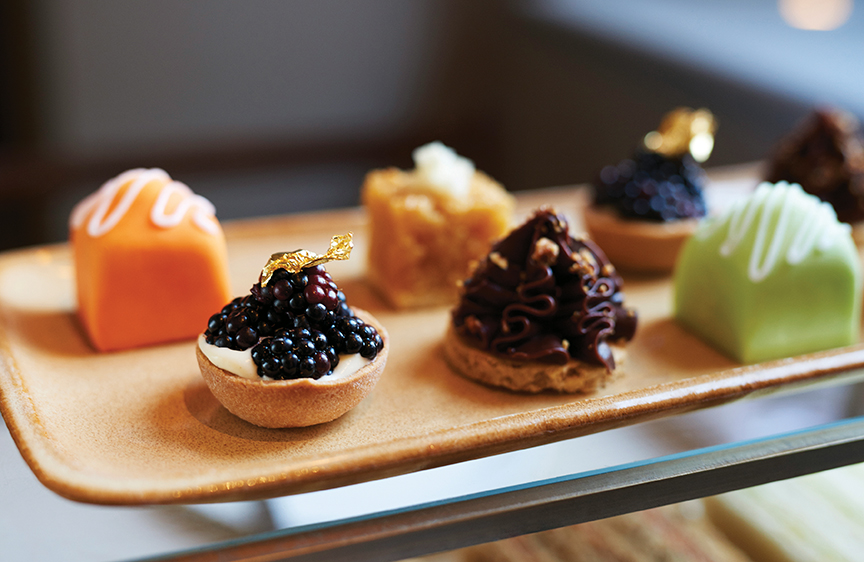
Photo courtesy Burberry
In recent years, high-end fashion houses have begun expanding their brands into fashionable food ventures, ranging from fine dining locales to cultivated cafes and refined bars.
One of the most notable fashion designers to establish contemporary food businesses as a direct extension of a signature brand is famed American designer Ralph Lauren. In 1999, Lauren opened his first restaurant, RL, adjacent to the world’s largest Polo store in Chicago. Similar to his fashion ideology, the restaurant focused on American classics — but traded in its collared Polo shirts, cashmere sweaters and neckties for steaks, seafood, chops and sandwiches.
RL, along with his subsequent restaurants, The Polo Bar in New York and Ralph’s on Boulevard Saint Germain in Paris, all have found ways to embody aspects of his iconic style.
Lauren’s newest venture is Ralph’s Coffee & Bar in London, located just next door to his flagship European store — a space that spans over 3 floors of product — on the iconic shopping stretch of Regent Street. The club-like atmosphere offers a decor that fits the designer’s equestrian aesthetic, and utilizes materials such as leather, brass and dark wood paneling.
“Ralph’s Coffee & Bar is a natural extension of the heritage of Polo and will add yet another dimension to the worlds we create,” said Lauren of the bar’s opening in January 2017. “I’ve always imagined our stores as a place for customers to experience a world. [This location] will add to that experience by offering a warm, friendly place to sit cozily with friends and family to sip a cup of our distinctive coffee or toast a special moment with one of our unique cocktails.”
Ralph’s Coffee & Bar
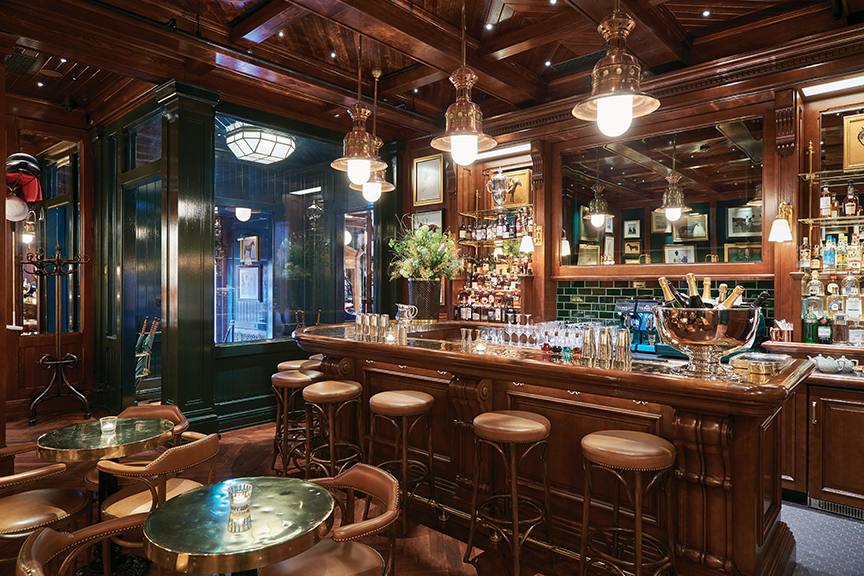
Photo courtesy Ralph Lauren
173 Regent Street
Mayfair, London W1B 4JQ
+44.(0)20.7113.7450
Jonathan Hatchman, food editor for The London Economic, believes Ralph’s Coffee & Bar meets its intent and holds up the Ralph Lauren image. “The bar completely epitomizes everything expected from Ralph Lauren: from the equestrian and polo themed accents, brass-topped bar, saddle leather seats and a palette of rich browns and bottle green,” he says.
While the menu follows suit with American classics, it has also embraced European elements. The bar sells three signature cocktails specifically created for the London location: Regent Street Sour, Ralph’s Winter Punch and Ralph’s Evening Roast.
During his visit, Hatchman indulged in the bar’s beverages and complementary snacks — especially the “ludicrously delicious” breaded and deep-fried olives. “I particularly enjoyed ‘The Chairman’ — a rye whiskey cocktail with an absinthe rinse, both typical Sazerac components and one of my favorite cocktails,” he says. “The bar’s take on an ‘Old Fashioned’ was good, too, served in a huge polo-etched glass, made with woody Eagle Rare bourbon.”
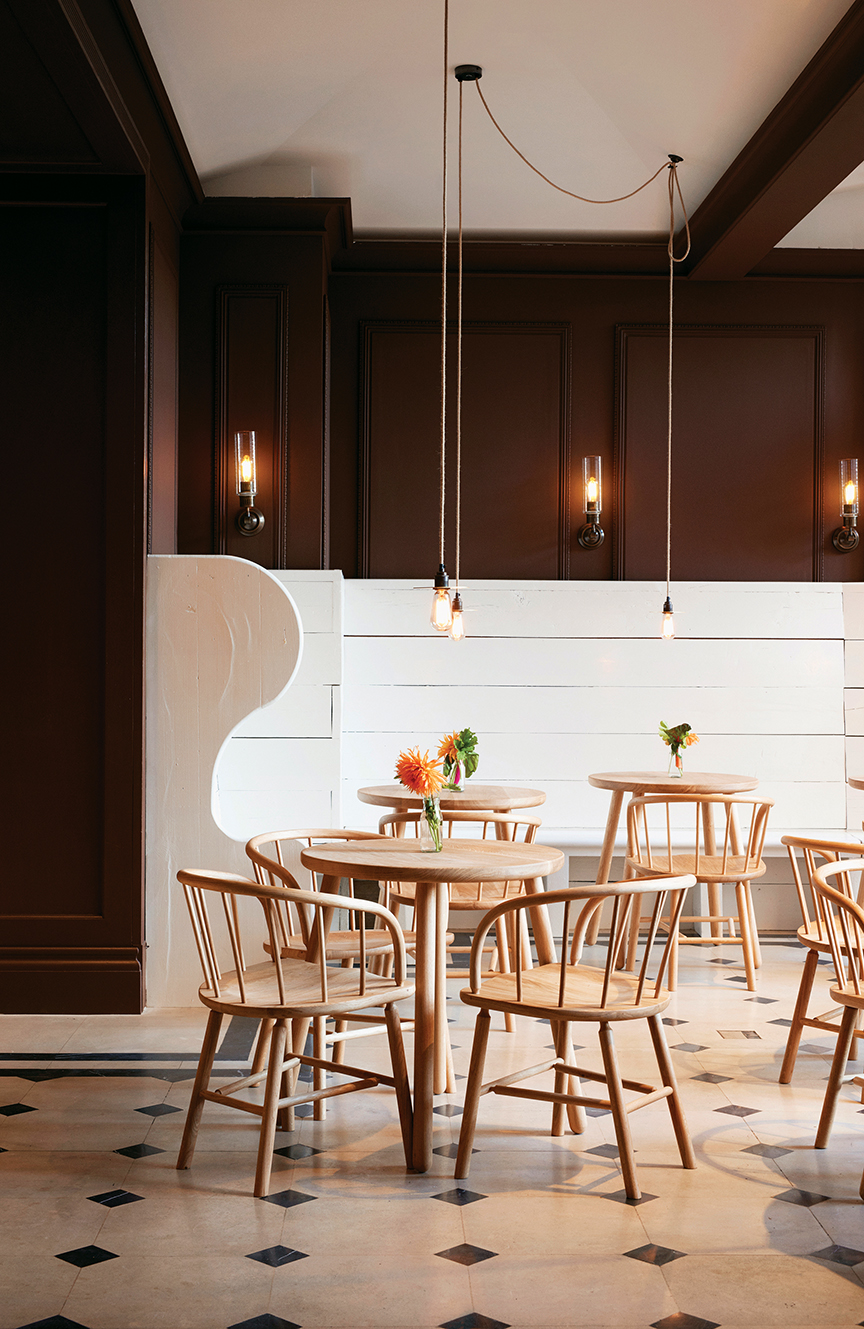
Photo courtesy Burberry
Thomas’s at Burberry Regent Street
5 Vigo Street
London W1S 3HA
+44.(0)20.3159.1410
A few minutes down Regent Street, another famed fashion brand has quite literally broadened its label into a culinary eatery. Known for its iconic trench coats and classic trademark tartan plaid, British luxury fashion house Burberry is also giving its clientele an equally posh spot to dine as their clothes have given them to wear.
Named for its founder, Thomas Burberry, Thomas’s is described as an “all-day dining destination” within the company’s flagship London store. This particular location offers a special gift area, as well as in-store monogramming services so that leather accessories and luxury goods can be embellished with one’s initials.
With a menu ranging from lobster to finger sandwiches and English cakes, Thomas’s is a sophisticated cafe for both a shopping break or a social meal. What’s better than concluding a Burberry shopping spree with a fine cup of tea and a locally sourced lunch?
“All of the produce is sourced from British small farms and artisan suppliers, while the decor is quite simple with marble-topped tables, dark-wood chairs and plenty of natural light that floods the room,” says Hatchman. “Inside, the cafe is, essentially, a continuation of the store, with friendly, unthreatened service, as expected from a high-end retail space.”
“Thomas’s is very much an extension of the store,” says Hatchman. “It would appeal most to central London shoppers — either customers of Burberry, or surrounding Regent Street shops.”
Hatchman visited the store-cafe for Breakfast at Burberry. “For me, the quality of carefully selected produce really stood out,” he says. “In terms of food, the full English breakfast is a million miles from the greasy spoon classic, but it’s a fair, refined version that doesn’t skimp on quality or on the meat. I remember the black pudding being particularly delicious.”
Yet, aside from the cafe’s quite literal connection with its store, the restaurant refrained from becoming a physical manifestation of its iconic Burberry clothes. “Thomas’s is very much an extension of the store,” says Hatchman. “It would appeal most to central London shoppers — either customers of Burberry, or surrounding Regent Street shops.”
Rather than extend its brand, Burberry has extended its store’s space into the realm of nourishment. “I wouldn’t say that the cafe is a complete embodiment of the brand’s style,” he says. “But — like Burberry — the cafe is staunchly British and proud.”
www.JonathanHatchman.com
info@JonathanHatchman.com
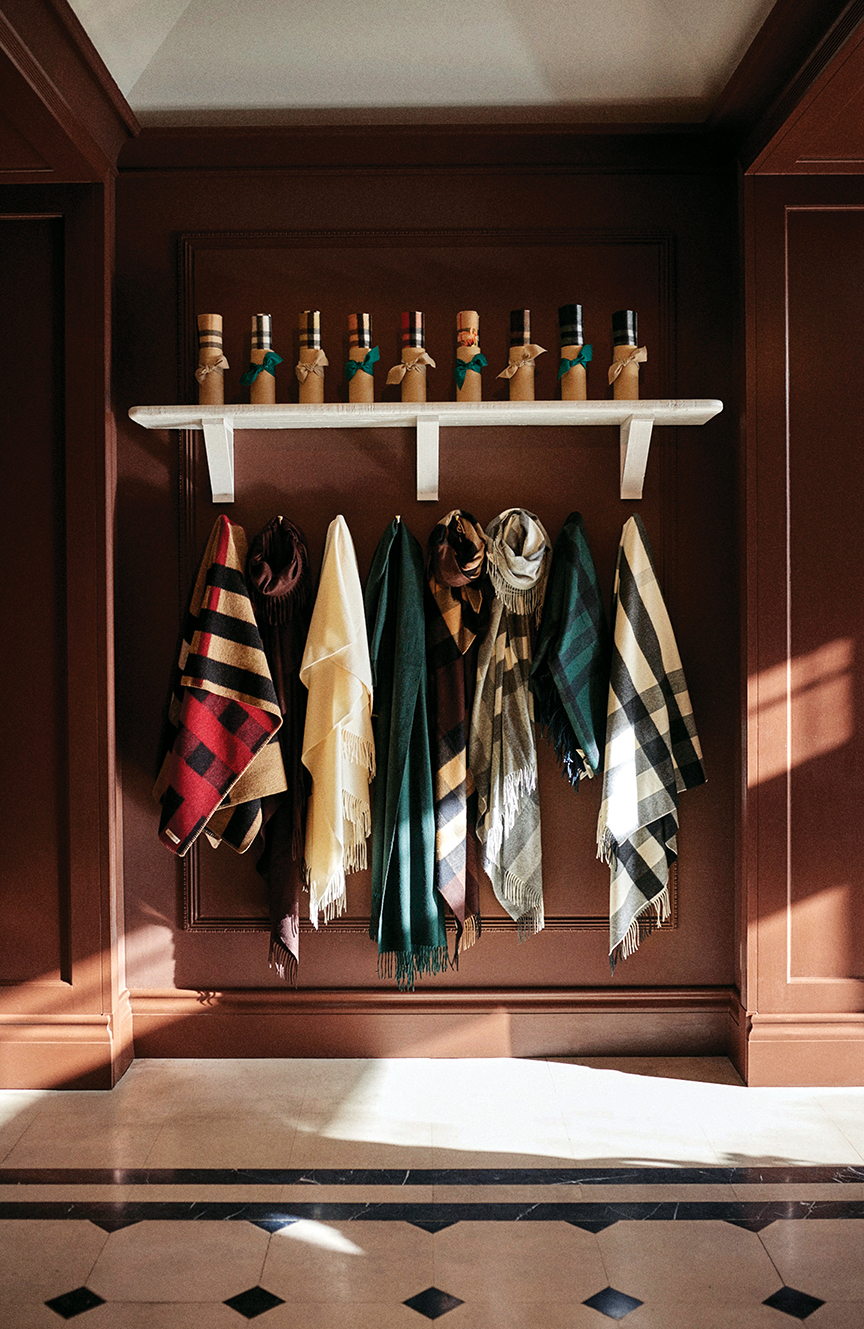
Photo courtesy Burberry
Armani / Ristorante 5th Avenue
While Ralph Lauren and Burberry have effectively incorporated restaurants into their brand’s empire, others have been unsuccessful, with their restaurants disappearing quickly after the initial buzz diminished. Take Marc Jacobs Café in Milan or Cavalli Miami Restaurant & Lounge.
Armani, however, has not had a problem.
Across the sea, immersed in the heart of Manhattan overlooking New York’s own shopping stretch — 5th Avenue — is Armani/Ristorante, one of the slew of restaurants bearing the name of the Italian mega-designer. You don’t have to travel far to find a Giorgio Armani restaurant venture — Armani Restaurants have been steadily popping up across the Americas, Europe and Asia for years, and now have over a dozen locations.
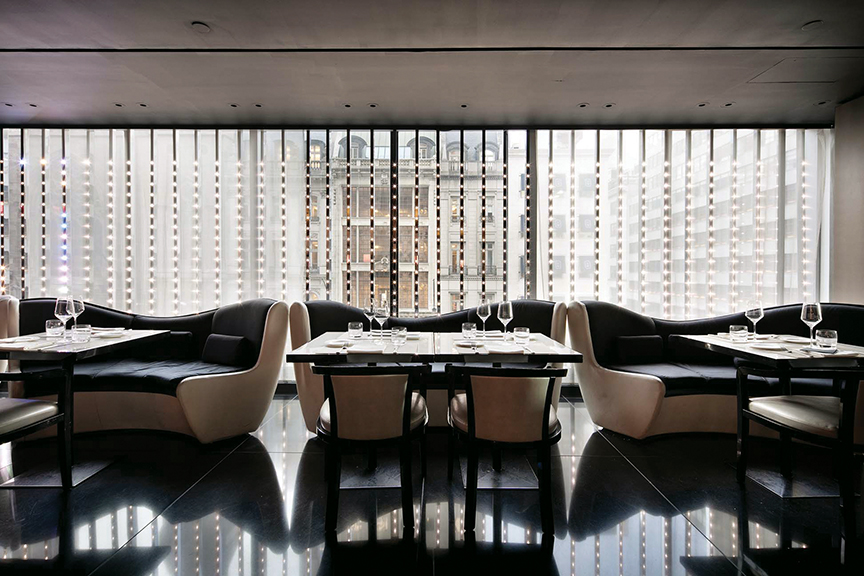
Photo courtesy Giorgio Armani
717 5th Avenue
3rd Floor
New York, NY 10175
212.207.1902
This particular Armani restaurant can be found on the third level of the Armani/5th Avenue store. Designed by Fuksas, the heart of the building is the sculptural steel staircase that leads customers to and from Armani-curated shopping and dining. The restaurant incorporates an Italian-inspired trendy style through a commanding backdrop of black and white, sleek curves and straight lines and furbished LED lights that give it the edge it needs.
Armani/Ristorante is structured in true Italian fashion — antipasti, primi piatti, secondi, and also offers breakfast and lunch, most likely for visitors to its bustling store.
Although epitomizing Armani’s sleek, hard-edged style, Armani restaurants are beyond a re-creation of his style in restaurant format. In fact, his locations have bolstered into culinary expeditions and have seen partnerships with some of the world’s top chefs, such as Milan’s Armani/Nobu, where he created a restaurant with celebrity chef Nobu Matsuhisa. The polished restaurant is unmistakably Armani, yet has a warm Japanese influence in both the design details and of course, the food.
Usually viewed as the nemesis of brick-and-mortar shops, technology is now being employed by retailers to draw people back to the mall.
By Roger Grody
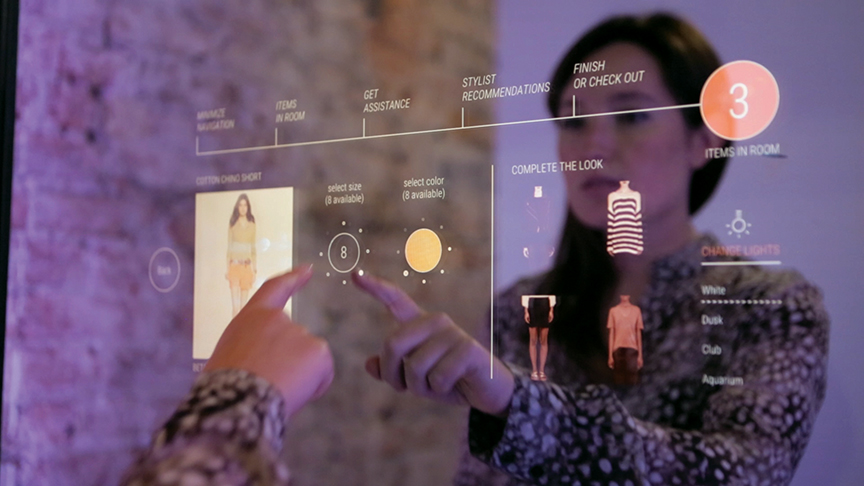
With RFID technology, fitting rooms become interactive. Photo courtesy Oak Labs.
Adjusting to a fundamental shift in how the world shops, retail establishments are struggling to retain customers who have become accustomed to shopping online in their pajamas, or while sipping a latte at their neighborhood café. To get people back to the mall, retailers must offer a more compelling experience, and for some, technology is not the enemy, but the answer.
Fashion designer Rebecca Minkoff, who parlayed a flirty “downtown romantic” style into a global lifestyle brand, is also one of the most technologically ambitious retailers. At her boutiques in New York, San Francisco and L.A., the experience begins at a large touchscreen from which customers can order cappuccino or Champagne, delivered to them as they browse.
At her boutiques, Minkoff has also introduced technology to the dressing rooms, equipped with mirrors doubling as interactive touchscreens that allow customers to adjust the lighting and request alternate sizes or styles. In addition, the “smart mirrors” detect the radio-frequency identification (RFID)-tagged garments and suggest matching pieces or accessories. “The amount of embedded tech that has gone into this retail embodiment has given us the opportunity to reach our ultimate goal in catering to next-generation shoppers,” says Uri Minkoff, the designer’s brother and company CEO.
Burberry, the iconic British luxury brand, also has demonstrated a strong commitment to technology, first at its global flagship store on London’s Regent Street and subsequently at its Shanghai flagship, the largest of seven locations in that city. The illumination of the sleek Shanghai façade changes with the natural light, while 40 strategically placed video screens and 130 speakers reinforce a decidedly high-tech interior.
Using RFID technology, a multimedia experience is triggered every time a customer steps into a dressing room at Burberry Shanghai. Not only are mirrors transformed into video screens — displaying images from a Parisian fashion show, for instance — but product specs and other relevant information are also presented to the customer.
William Toney, vice president of global RFID market development at Avery Dennison, a leader in the field, reports retailers are rapidly embracing this technology. His company manufactures tiny ultra-high-frequency RFID antennae with integrated chips that are adhered to price stickers or sewn-in labels, unnoticed by shoppers.
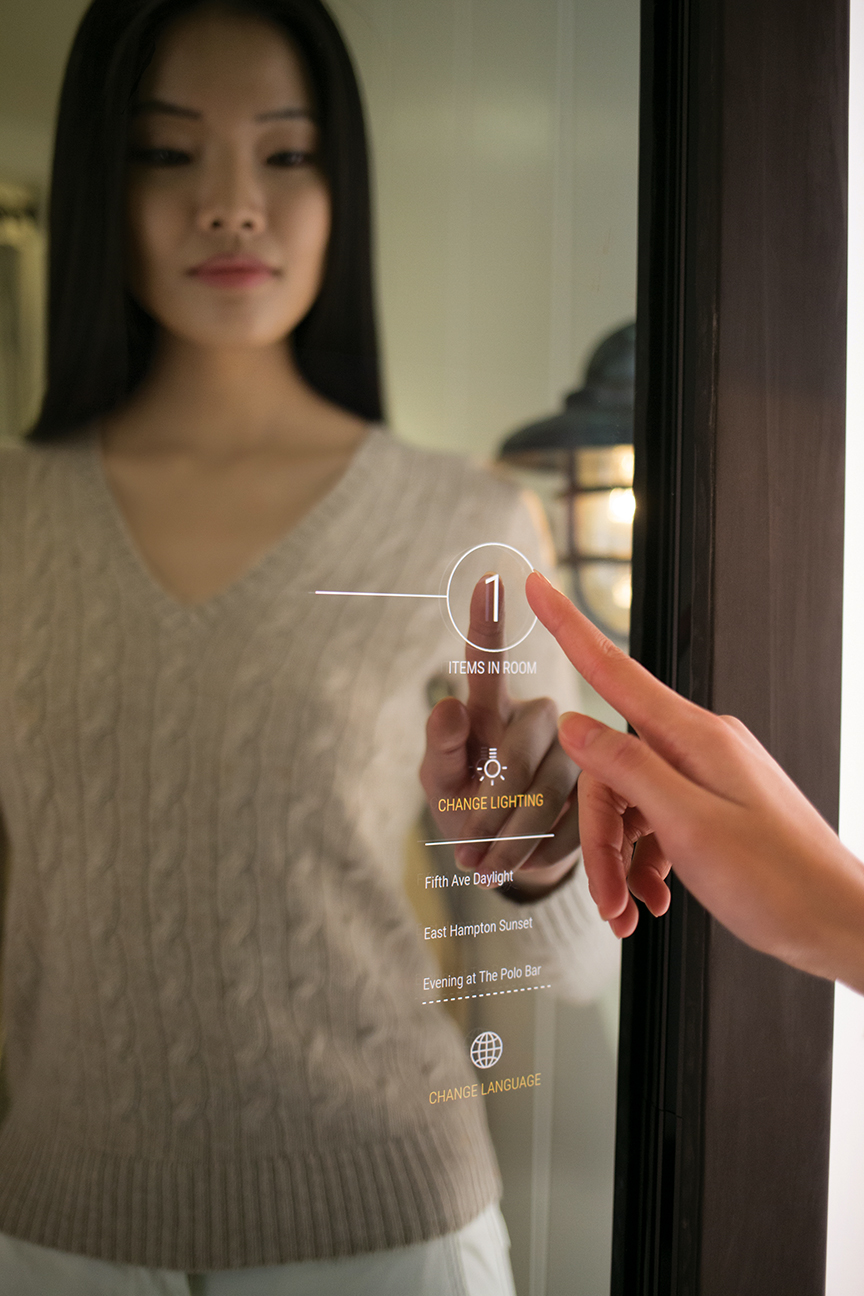
Oak Labs’ smart mirrors transform shopping at Ralph Lauren boutiques. Photo courtesy Oak Labs.
These stickers, which can be scanned from a distance, have revolutionized retail inventory management. Recognizing that customers’ greatest frustration is not being able to find what they’re looking for, retailers welcome the opportunity to increase inventory accuracy from an industry average of 65 percent to 95-plus percent, explains Toney.
By collaborating with high-tech companies like Oak Labs, Avery Dennison’s RFID tags can trigger the interactive experiences pioneered by Rebecca Minkoff and Burberry. “Retailers are beginning to realize the definition of ‘mobile’ is quickly moving away from mobile apps and towards a reality where patrons keep their heads up as the store changes around them,” says Oak Labs CEO Healey Cypher, whose full-length touchscreen mirrors are live at selected Ralph Lauren stores.
“Without anybody having to scan anything, a garment comes to life in the dressing room,” says Toney, who explains the mirror identifies what the customer has brought in and gives her or him an opportunity to interact with the store’s resources. “The greatest contribution of this technology is that it elevates the shopping experience for the consumer,” he maintains.
At its stores in New York, San Francisco and London, outdoor apparel and equipment retailer The North Face offers customers a virtual reality (VR) experience through a collaboration with Jaunt, a Silicon Valley startup. The content, filmed with Jaunt’s proprietary cameras and microphones, provides a fully immersive experience of trekking in Nepal with professional rock climber Renan Ozturk.
“Virtual reality is a powerful medium that has the ability to introduce audiences to incredible people in amazing places,” says Cliff Plumer, president of Jaunt Studios. For The North Face, VR represents an innovative way to share its passion for the outdoors and inspire customers to equip themselves for new adventures.
On The Web
Burberry: www.burberry.com
Ralph Lauren: www.ralphlauren.com
Rebecca Minkoff: www.rebeccaminkoff.com
The North Face: www.thenorthface.com
Avery Dennison: www.averydennison.com
Jaunt: www.jauntvr.com
Oak Labs: www.oaklabs.is
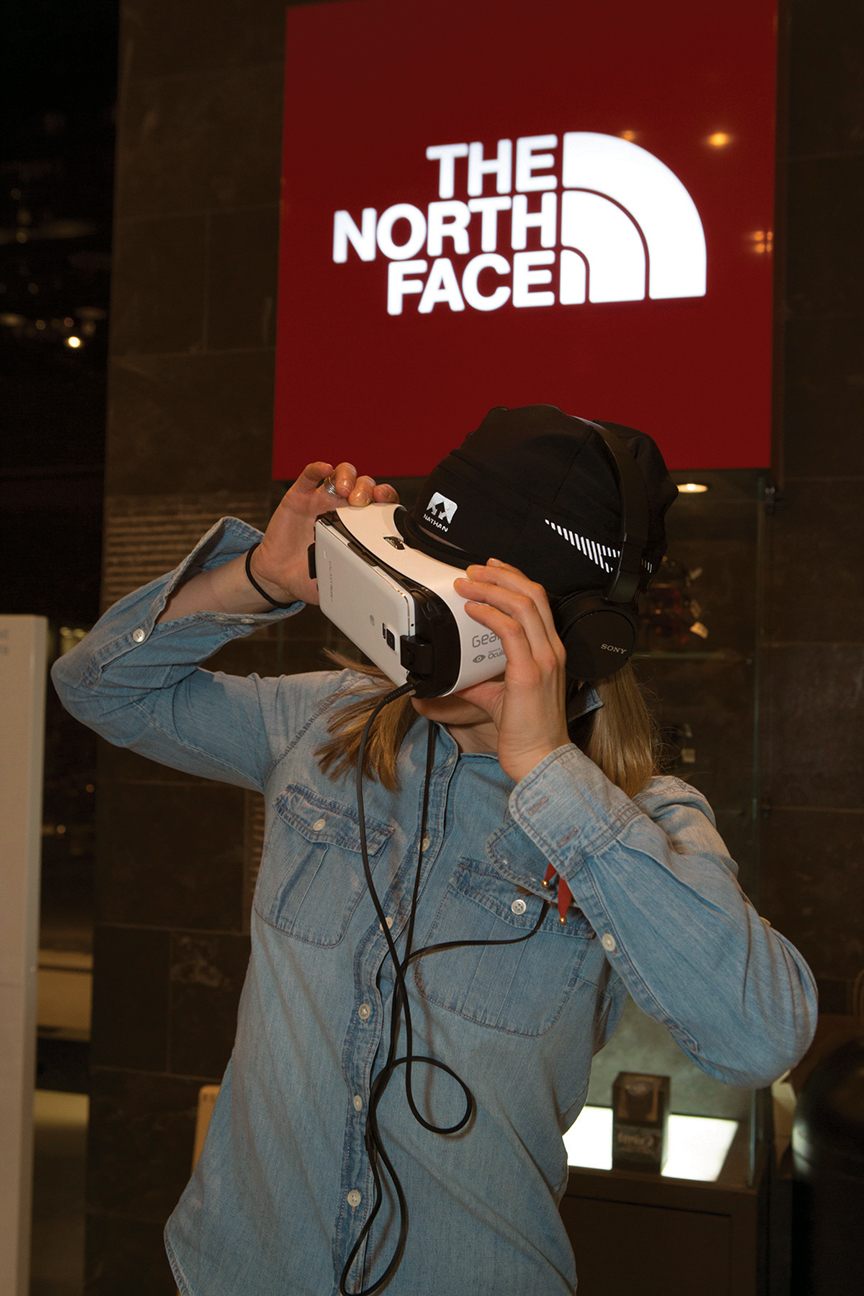
At The North Face, virtual reality transports customers to Nepal; Photo courtesy The North Face.














